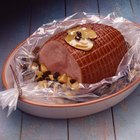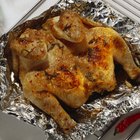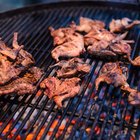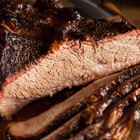LightFieldStudios/iStock/GettyImages
Commercial kitchens usually have huge quantities of oven space available for special occasions. That's not the case at home, where any holiday meal can quickly lay claim to all the oven space you can muster. Roaster ovens are one way to compensate for that, a convenient countertop appliance that provides extra cooking capacity in a compact form. They're also energy-efficient, and less likely to heat up your kitchen. Cooking in one is slightly different from cooking in your oven.
How They Work
Countertop roaster ovens come in different sizes and shapes, but they all follow a similar method. The appliance consists of an outer shell containing the controls, a heating element and an inner roaster for the food. It's essentially a high-temperature equivalent to your slow cooker, and the basic design has been around since the 1930s. They're poorly suited for baking, but work well for roasting meats and poultry. Cooking with a countertop roaster requires a few adjustments from cooking in a conventional oven, but they're relatively minor.
You'll Get Moister Roasts...
It helps to think of the roaster as a pan, rather than an oven. Your roast or turkey sits in a relatively small space with a tight-fitting lid, just as it would in a covered roasting pan in your regular oven. In this small space, the moisture that evaporates from your meat as it cooks is trapped in the form of steam. The dry air of a conventional oven can cause your roast to shrink dramatically or your turkey to dry out, which is why many recipes call for basting. That doesn't happen in a roaster. However, the down side to that moist cooking is that it inhibits browning.
...But Less Browning
Meats brown when the amino acids in their proteins break up under the stress of high heat, and reform into new and more complex molecules. That's why browned meats have such rich, savory flavors. Unfortunately moist air slows the process, because the surface must reach temperatures well above the boiling point of water and they can't do that when they're continually moistened by the trapped steam. You can achieve a degree of browning by oiling the surface of a bird or a roast, which will help it repel moisture. If you want more browning, or a crisp skin on a turkey or chicken, it's best to simply transfer the meat to your regular oven for the last 30 minutes of cooking time.
Heat Loss
Another crucial difference between roasting in your oven and using a roaster is the issue of heat loss. Opening your oven causes some heat loss, which is why many cooks bakers preheat to a higher temperature and then lower it when the roast goes in. Opening the oven periodically to baste your bird or test a roast for doneness also causes heat loss, but the oven's powerful heating elements or gas flame quickly restore it to the correct temperature. In a roaster, with its smaller volume of air and modest heating elements, opening the lid has a more dramatic effect. Leave the lid in place whenever possible, and use a thermometer with a remote display to monitor your roast's doneness.
Related Articles

Does a Roaster Oven Cook Faster Than ...

Cooking Poultry With a Convection Vs. ...

How to Clean an Oven Liner

How to Use Reynolds Oven Bags

Should I Glaze Ham if I'm Baking in a ...

How to Cook Prime Rib Using an Oven ...

How Do Cooking Bags Shorten Cooking ...
How Long to Thaw a Frozen Turkey
How to Cook Prime Rib Roast in a ...
Convection Broiling Vs. Convection ...

How to Cook Chicken Breasts in a ...

What Depth Is Considered a Shallow ...

Difference Between Baking on the Top & ...
How to Cook in Tabletop Convection Ovens

How to Cook a Partridge

How to Cook Chicken in a Schlemmertopf ...

How to Cook a Goose on the Grill

How to Roast a Stuffed Chicken in a ...

How to Bake a Pork Loin Center Half

How to Steam a Brisket of Beef
References
- Rival: Product FAQs -- Roasters
- Jitterbuzz.com: Collectible Westinghouse Roaster Identification Chart
- On Food and Cooking: The Science and Lore of the Kitchen; Harold McGee
Writer Bio
Fred Decker is a trained chef and prolific freelance writer. In previous careers, he sold insurance and mutual funds, and was a longtime retailer. He was educated at Memorial University of Newfoundland and the Northern Alberta Institute of Technology. His articles have appeared on numerous home and garden sites including GoneOutdoors, TheNest and eHow.